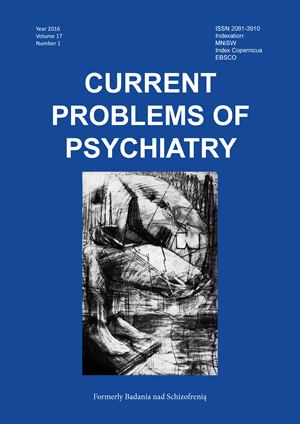The case of inorganic hypersomnia treated with light therapy in the course of schizoaffective disorder
DOI:
https://doi.org/10.1515/cpp-2016-0002Keywords:
nonorganic hipersomnia, schizoaffective disorder, treatmentAbstract
According to ICD 10, nonorganic hypersomnia is defined as “a condition of either excessive daytime sleepiness and sleep attacks (not accounted for by an inadequate amount of sleep) or prolonged transition to the fully aroused state upon awakening. When no definite evidence of organic etiology can be found, this condition is usually associated with mental disorders”. The severe hypersomnia in the course of schizoaffective disorder is rather a rare phenomenon. The paper presents the case of 41-year-old female patient with severe hypersomnia during the course of the schizoaffective disorder. The course of hypersomnia was severe. The patient slept constantly day and night and was awoken by her family for about three-hour period of time. The duration of hypersomnia was about one year until the onset of treatment. The patient was successfully treated with light therapy that caused gradual resolution of the symptoms of hypersomnia. The patient is also treated as prior to the onset of hypersomnia with antipsychotics and the mood stabilizers for schizoaffective disorder. Since that time there were six-year-period of follow up when the patient was free of any symptoms of hypersomnia.
References
1. The ICD-10 Classification of Mental and Behavioural Disorders. Clinical descriptions and diagnostic guidelines [online]. World Health Organization. [access: 4 March 2013]. Access in World Wide Web: <http://www.who.int/classifications/icd/en/bluebook.pdf>;.
2. Partinen M., Hublin C. Epidemiology of sleep disorders. W: Kryger M.H., Roth T., Dement W.C. red. Principles and Practice of Sleep Medi-cine. Wyd. 4. Elsevier/Saunders, Philadelphia 2005; 626–647.
3. 3.Szelenberger W., Skalski M. Epidemiologia zaburzeń snu w Polsce. Doniesienie wstępne. W: Nowicki Z., Szelenberger W. (red.). Zaburzenia snu. Diagnostyka i leczenie, wybrane zagad-nienia. Biblioteka Psychiatrii Polskiej. Biblioteka Psychiatrii Polskiej Kraków 1999; 57–63.
4. Walacik E., Fornal M., Szelenberger W. Cechy osobowości pacjentów z hipersomnią nieorganiczną. Sen 2007; 7 : 1-7.
5. Wichniak A., Waliniowska E., Wierzbicka A., Czasak K., Musińska I., Szatkowska E., Jernajczyk W., Jarema M. Jakość snu i senność w ciągu dnia w zaburzeniach psychotycznych z kręgu schizofrenii w trakcie leczenia lekami przeciwpsychotycznymi. Psychiatria Polska 2009; 43(2) : 193-202.
6. Saletu B., Anderer P., Saletu-Zyhlarz G.M. Nonorganic hypersomnia: epidemiology, diagnosis, and therapy. Wiener Medizinische Wochenschrift 2001; 113 : 266-77.
7. Johns M.W. A new method for measuring daytime sleepiness: the Epworth sleepiness scale. Sleep, 1991;14(6) : 540-545.
8. Ekiert, H., and W. Jernajczyk. "Normy wzorca eeg snu dla zdrowej populacji polskiej w wieku 20-59 lat. Psychiatria Polska 1992; 26: 501-501.
Downloads
Published
Issue
Section
License
Copyright (c) 2016 Authors

This work is licensed under a Creative Commons Attribution-NonCommercial-NoDerivatives 3.0 Unported License.


